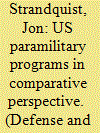| Srl | Item |
| 1 |
ID:
157892


|
|
|
|
|
| Summary/Abstract |
The special operations forces (SOF) of the industrial democracies have suddenly and rapidly grown in numbers and resources during the past decades. Most explanations for this growth focus on factors external to the armed forces. We argue that the enlargement of SOF is also the result of internal organizational dynamics. First, we compare SOF to other units and military appendages that have grown over the past 30 years in order to delineate what is unique to their development and the special adaptive potential they bring to the armed forces: generalized specialization, boundary spanning roles, and enlargement of military autonomy. Second, we analyze the actions of internal military entrepreneurs and their organizational mentors to show how they use this adaptive potential to “sell” the use of SOF to key policy-makers and decision-makers.
|
|
|
|
|
|
|
|
|
|
|
|
|
|
|
|
| 2 |
ID:
154330


|
|
|
|
|
| Summary/Abstract |
Assumed in the long-standing debate over which agency, CIA or the Department of Defense, should conduct US paramilitary operations is the idea that these organizations’ paramilitary programs are fundamentally the same kinds of things. This article questions that assumption by investigating the organizational forms underlying these agencies’ paramilitary programs in four empirical cases drawn from South Vietnam and post-9/11 Afghanistan. A typology is constructed around two identified organizational forms: “franchising” for CIA vs. “company ownership” for the US Army Special Forces. Different paramilitary organizational forms are found to have significant operational implications that should inform the paramilitary transfer debate.
|
|
|
|
|
|
|
|
|
|
|
|
|
|
|
|
| 3 |
ID:
135218


|
|
|
|
|
| Summary/Abstract |
There is no question that the number of United States Special Operations Forces (SOF) is growing. This paper argues that focusing on the increase in size obscures what should be the real debate: what kind of SOF should the US employ in the twenty-first century? I conclude with two ideas: that SOF’s best capability is at the tactical level, and that the largest benefit they can provide a democracy is in the conduct of special warfare, and not the more popular surgical strike operations. It would be wise, therefore, for democracies to resist the natural inclination to grow SOF simply because they perceive a growth in asymmetric threats. SOF, conducting special warfare, can offer democracies both a “special” capability and also more subtle, longer-term influence than is normally associated with conventional armed forces.
|
|
|
|
|
|
|
|
|
|
|
|
|
|
|
|